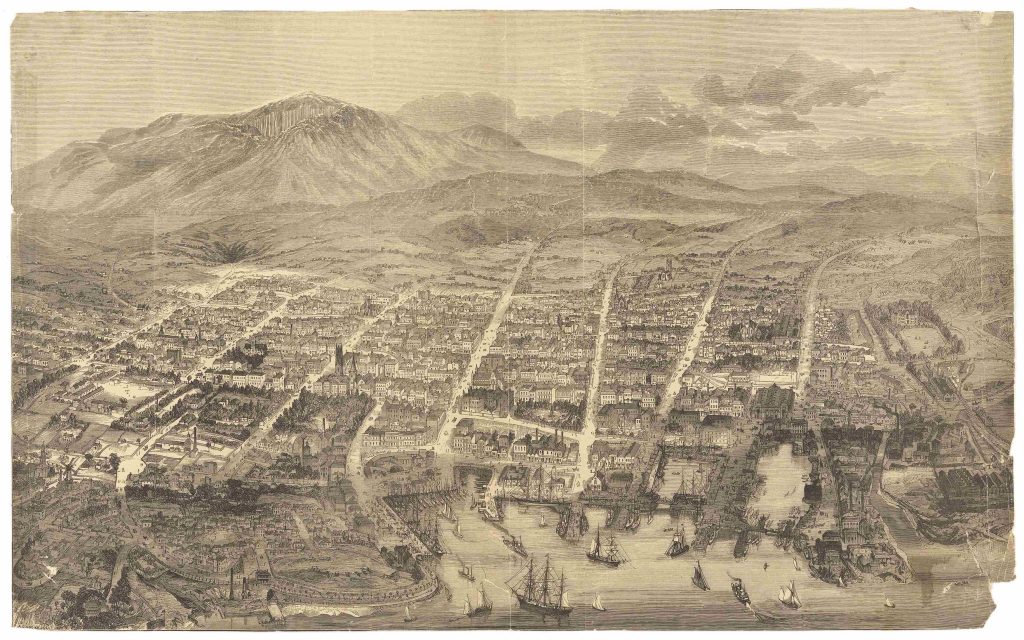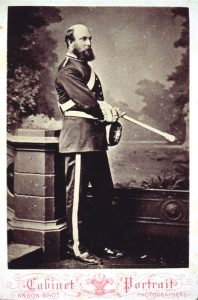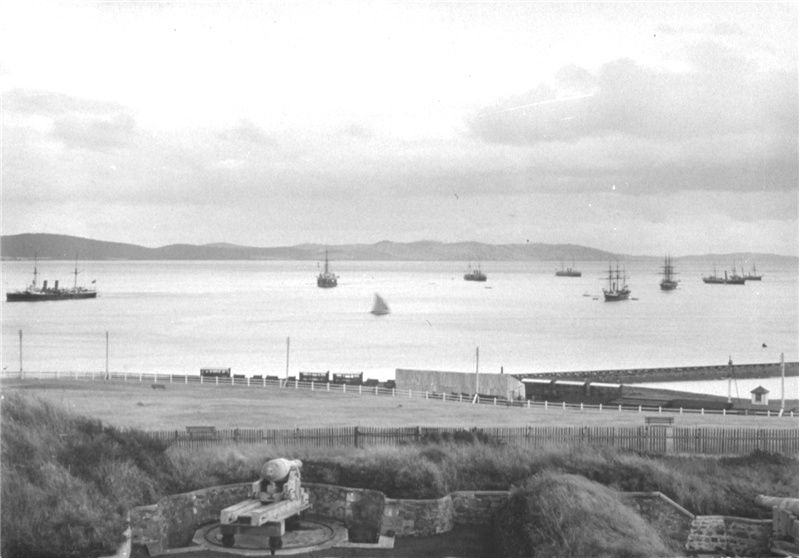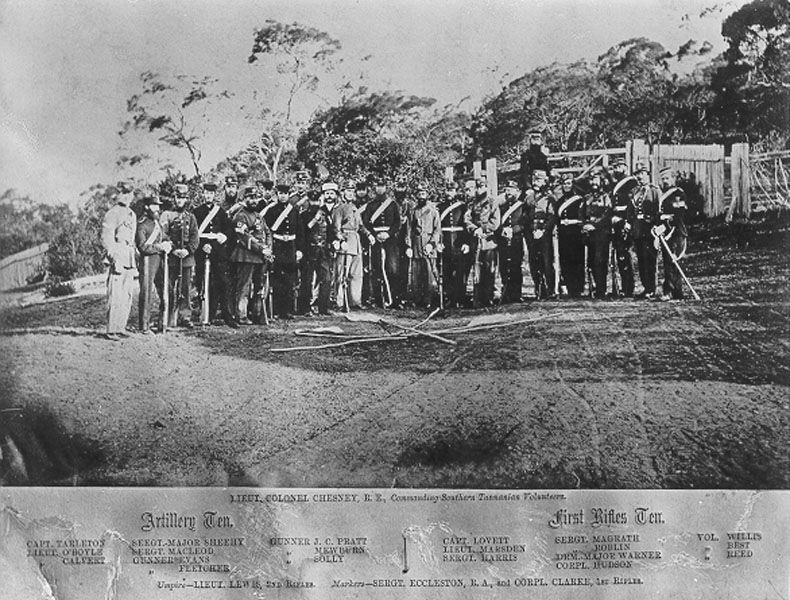The Southern Tasmanian Volunteer Artillery

Have you ever driven past the Alexandra Battery in Sandy Bay and wondered what it was for? Have you ever heard rumours of a planned Russian invasion of Tasmania in the 19th century? As Anzac Day approaches, we’d like to share the story of the Southern Volunteer Artillery Regiment with you. Thanks to our new corps of online volunteers, we can now tell this amazing story in a new way, preserve it for future generations, and maybe even link it to your own family history. Intrigued? Want to get involved? Read on!
Great Guns and the ‘Great Game’ in the Far South

The question of how to defend Hobart dates back to the very beginning of the colony. When French invasion threatened in 1811, naval ship guns on wooden platforms were installed beneath the old Government House (where Franklin Square now stands). The battery at Mulgrave Point was constructed in 1818 and more batteries followed between 1841 and 1885: at the aptly-named Battery Point, at Macquarie Point, on the Domain, at Sandy Bay, and on Kangaroo Bluff.
Why were there so many guns? Part of the answer lies many thousands of miles to the north, and to the periodic war scares of the so-called “Great Game,” the contest between the British and Russian Empires. Throughout the nineteenth century, Anglo-Russian tensions sparked conflicts around the globe (including the First Afghan War from 1839-1842, the Crimean War from 1854-1856, the Second Afghan War from 1878-1879, and the Bulgarian Crisis of 1881). It spawned networks of running spies and counter-espionage that crossed the Indian subcontinent and Central Asia, and gave rise to great characters in literature (including Dr. John Watson of Sherlock Holmes fame, and Rudyard Kipling’s Kim).
In Hobart, these global tensions played out in complicated ways. When Russian naval ships visited on scientific missions (like the Boyarin in 1870), Hobart welcomed them with fetes, elaborate toasts, and tours of the city. But nevertheless, among many Tasmanians, there was a general feeling that a Russian invasion was imminent, as a letter to the editor of the Mercury pointed out in 1885,
“Many persons say the insignificance of Tasmania is its protection, but we must respect the authority of military men, who say if an attack is made on the colonies, this is to be honoured with the first call.”
Manning the Guns: The Southern Volunteer Artillery

With the port of Hobart quite literally bristling with heavy weaponry, men were needed to man the guns. From 1858 to 1903, hundreds of local enthusiasts – possibly including veterans of the Crimean War of 1854-56,and the Indian Rebellion of 1857 – joined the Southern Volunteer Artillery. In the Handbook of the Tasmanian Artillery Volunteers (1868), R.H. Eccleston described desirable qualities in volunteer gunners, who would have to work together to bombard an enemy vessel in the Derwent, pulverizing it with 365 cannon shells within half an hour. He added,
“Men necessary to perform the above work would have to be well drilled and of good pluck”

Joining the volunteer defence force was a real badge of honor. Members were drawn from across the social classes – from the colonial elite (like Thomas Roblin, a museum curator), to those from more humble backgrounds (like Charles Read, a baker at Cascades). Dr. Edward Lodewyk Crowther (1843–1931) was a Major in the force, and wrote a brief history of the volunteer effort (which you can find in the massive collection donated to the State Library by his son, William Edward Lodewyk Hamilton Crowther).
The Crowthers were the cream of colonial society, but if you were trying to climb the social ladder, wearing these splendid uniforms and rubbing shoulders with Hobart’s elite was a solid route to respectability. So, too, were the opportunities to join in parades or to participate in community social functions, like a “Grand Promenade Concert” that the Southern Volunteer Artillery put on in the Town Hall in 1878. But beware! Any whiff that you might join up just for the fun of it might get you teased in the local papers.
A New Volunteer Corps
The story of the Southern Volunteer Artillery is much bigger than we could possibly tell here, and it’s about to get even more interesting. You can now view the Registers of Volunteers of the Southern Tasmanian Volunteer Artillery (COM1/20) on our website, and thanks to our amazing digital volunteers, you can also search search for individuals in our Tasmanian Names Index, and maybe even write your own part of the story!
We’re not quite finished with this project, and we have many more lined up. If you’d like to participate, please check out our DigiVol Expeditions. You can register as a digital volunteer and help us transcribe these and other records that tell amazing Tasmanian stories.
Want to Find Out More?
You can visit the gun emplacements at Alexandra Battery, and see some of the original guns on display at the Army Museum of Tasmania at Anglesea Barracks in Davey Street.
Our colleagues at the National Archives have a digitized history of the Southern Volunteer Artillery, written in 1925 which you can view online here.
There’s also heaps more to discover about the Southern Tasmanian Volunteers in our collections – check out this Southern Volunteer Artillery list.
Archival Sources (Primary Sources)
Books and Articles Available in the Library or Online (Secondary Sources)
Douglas Morris Wyatt. Tasmanian Colonial Artillery, 1803-1903.
The University of Chicago Library has an amazing collection of 19th century maps that show the changing relationship between British and Russian borders in the nineteenth century. You can click on different regions of the map, or test your Cyrillic skills by browsing the list.




Hi,
I have been told by my uncle (now long gone) that he and his contempories in the early 1900’s often searched for and found spent artillery shells on the eastern shores of Norfolk Bay. When found these shells could be passed in for a reward. He said that they got quite good at finding them from the damage marks that they left in trees. I was also told that the the rocks along the shoreline in certain locations were painted white to assist with this artllery practice.
I would be interesed to know if any of your colleagues have knowledge of these practices or where I might search to get further information.
Hi Bob,
How interesting! The newspapers would probably be the best source of information. You can search most of them online via Trove <https://trove.nla.gov.au/search/advanced/category/newspapers>, or our catalogue for the Weekly Courier and Tasmanian Mail.
Hi
Do you have any further information about membership in the Artillery of Joseph Hone (1784-1861). I
An article in the Mercury reporting on his funeral states that he was a member of the “Artillery and Second Rifle Corps” – https://trove.nla.gov.au/newspaper/article/8801297.
Do we know anything about his role in the Artillery? Perhaps it was purely social given that he was Master of the Tasmanian Supreme Court (1824-1836, 1840-1851), and also held other legal roles including Attorney-General for a short period.
Hi Jim, there are a number of records you might search for information on Joseph Hone’s role in the Southern Volunteer Artillery. These are located within the archives of the Volunteer Forces: https://libraries.tas.gov.au/Record/Archives/TA1105 and in the series ‘E L Crowther – Personal and Business Records (CRO19)’: https://libraries.tas.gov.au/Record/Archives/CRO19
Hello
I wonder if you can help me?
I am searching for information about a photo I have been given which can be seen at https://a-little-bit-of-this.co.uk/2018/04/04/unknown-soldiers/. I have received the following comment via the website.
‘My 4x Great grandfather was 51st Regiment of Foot,served in Tasmania and stayed in Hobart until his death in April 1871.The photo could be Hobart Volunteers..The Southern Tasmanian Volunteer Artillery.’
Would you be able to advise if they are Hobart volunteers?
Kind regards
Toni Louise Abram
Hello Toni
Apologies for the delay in our response. Unfortunately there is not much evidence to go on. The uniforms certainly do not resemble those of the Southern Tasmanian Volunteer Artillery – the cuff design is different and the hats are definitely not of the same type.
A well-written story, thanks Anna! Love the photo of the Queen’s battery. Do we know if any of it remains?
Thanks, Grace! My understanding is that the War Memorial is on the site of the old Queen’s Battery, which was covered over in 1925. I just found this terrific video that showcases some of TMAG’s photographs of the Battery and gives a bit more information not covered in our blog post – fascinating stuff! https://www.youtube.com/watch?v=hVEGkgDZMMg All the best, Anna